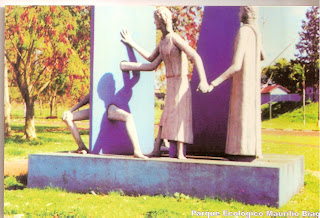Maria Inês - Sent postcards
quarta-feira, 21 de setembro de 2011
Centenário da Imigração Japonesa
I am Maria Inês, an English teacher. This postcard was sent to Canton - China.
In 1908, reached the port of Santos-SP, Brazil "Kasato Marú" ship that brough 165 families japaneses. Many of these immigrants was made up of peasants in poor areas of northernand southern Japan in the period of 1914-1918, a world war I, reached about 165.000 japaneses in Brazilian territory. Today in Brazil, concentrates the largest number of japanese. In Ribeirão Preto, many japaneses immigrants developed the cultivation of rice, corn and soybeans, poultry, rericulture (silkworm rearing of silkworms) and horticulture.
In 1908, reached the port of Santos-SP, Brazil "Kasato Marú" ship that brough 165 families japaneses. Many of these immigrants was made up of peasants in poor areas of northernand southern Japan in the period of 1914-1918, a world war I, reached about 165.000 japaneses in Brazilian territory. Today in Brazil, concentrates the largest number of japanese. In Ribeirão Preto, many japaneses immigrants developed the cultivation of rice, corn and soybeans, poultry, rericulture (silkworm rearing of silkworms) and horticulture.
350 anos do Mosteiro de São Bento de Sorocaba - SP
Hello, my name is Maria Inês, I am a teacher, I have 55 years. I think your very beautiful country, but today I'll tell you a little bit of the culture of my country.
On 21/04/1661, the captain Balthazar Fernandes gave the Church of Our Lady of the Bridge, now Monastery of St. Benedict, the Benedictine monks in the town of Parnaiba today Sorocaba.
The Monastery of St. Benedict is a landmark history of Sorocaba - SP and monastic history and heritage worldwide.
On 21/04/1661, the captain Balthazar Fernandes gave the Church of Our Lady of the Bridge, now Monastery of St. Benedict, the Benedictine monks in the town of Parnaiba today Sorocaba.
The Monastery of St. Benedict is a landmark history of Sorocaba - SP and monastic history and heritage worldwide.
Estrada Real - Tesouro que a natureza conservou
I am Maria Inês, I have 55 years, I am a teacher. Today, I'll tell you a little about the culture of my country.
During the course of gold in the century. XVII and XVIII, in Loin of animals, leaving Minas Gerais, valuable positions that adorned churches in Brazil and Europe, and filled the coffers of the Portuguese Crown. On the same stretch, other charges between Diamantina (MG) and the ports of Rio de Janeiro and Paraty. The Royal Road carried gold, diamonds and precious stones in Minas Gerais for the rest of the world. Still retain that wealth began to be redescodertas.
During the course of gold in the century. XVII and XVIII, in Loin of animals, leaving Minas Gerais, valuable positions that adorned churches in Brazil and Europe, and filled the coffers of the Portuguese Crown. On the same stretch, other charges between Diamantina (MG) and the ports of Rio de Janeiro and Paraty. The Royal Road carried gold, diamonds and precious stones in Minas Gerais for the rest of the world. Still retain that wealth began to be redescodertas.
Igreja de Nossa Senhora do Rosário e São Benedito - Cuiabá - MT
I'm Maria Inês, an English teacher. This postcard was sent to Miss Annie, Wales - United Kingdom.
Por volta de 1750, tomou a forma de uma nave, sendo a nave, a ala esquerda de quem nela entra. Construída pela irmandade Nossa Senhora do Rosário. A ala à direita, a capela, pela irmandade de São Benedito. Tornou-se memorial Histórico brasileiro por lembrar a última fase da conquista paulista e portuguesa a terras espanholas à oeste da célebre linha de Tordesilhas e Memorial Artístico Mundial, por ser a única igreja setecentista cuiabana de Arte Barroca.
Por volta de 1750, tomou a forma de uma nave, sendo a nave, a ala esquerda de quem nela entra. Construída pela irmandade Nossa Senhora do Rosário. A ala à direita, a capela, pela irmandade de São Benedito. Tornou-se memorial Histórico brasileiro por lembrar a última fase da conquista paulista e portuguesa a terras espanholas à oeste da célebre linha de Tordesilhas e Memorial Artístico Mundial, por ser a única igreja setecentista cuiabana de Arte Barroca.
quarta-feira, 24 de agosto de 2011
Assinar:
Comentários (Atom)




